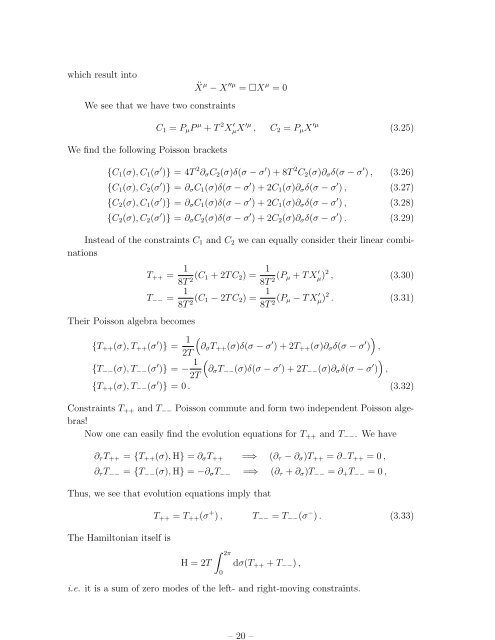Lectures on String Theory
Lectures on String Theory
Lectures on String Theory
Create successful ePaper yourself
Turn your PDF publications into a flip-book with our unique Google optimized e-Paper software.
– 20 –<br />
which result into<br />
We see that we have two c<strong>on</strong>straints<br />
We find the following Poiss<strong>on</strong> brackets<br />
Ẍ µ − X ′′µ = □X µ = 0<br />
C 1 = P µ P µ + T 2 X ′ µX ′µ , C 2 = P µ X ′µ (3.25)<br />
{C 1 (σ), C 1 (σ ′ )} = 4T 2 ∂ σ C 2 (σ)δ(σ − σ ′ ) + 8T 2 C 2 (σ)∂ σ δ(σ − σ ′ ) , (3.26)<br />
{C 1 (σ), C 2 (σ ′ )} = ∂ σ C 1 (σ)δ(σ − σ ′ ) + 2C 1 (σ)∂ σ δ(σ − σ ′ ) , (3.27)<br />
{C 2 (σ), C 1 (σ ′ )} = ∂ σ C 1 (σ)δ(σ − σ ′ ) + 2C 1 (σ)∂ σ δ(σ − σ ′ ) , (3.28)<br />
{C 2 (σ), C 2 (σ ′ )} = ∂ σ C 2 (σ)δ(σ − σ ′ ) + 2C 2 (σ)∂ σ δ(σ − σ ′ ) . (3.29)<br />
Instead of the c<strong>on</strong>straints C 1 and C 2 we can equally c<strong>on</strong>sider their linear combinati<strong>on</strong>s<br />
Their Poiss<strong>on</strong> algebra becomes<br />
T ++ = 1<br />
8T 2 (C 1 + 2T C 2 ) = 1<br />
8T 2 (P µ + T X ′ µ) 2 , (3.30)<br />
T −− = 1<br />
8T 2 (C 1 − 2T C 2 ) = 1<br />
8T 2 (P µ − T X ′ µ) 2 . (3.31)<br />
{T ++ (σ), T ++ (σ ′ )} = 1 (<br />
)<br />
∂ σ T ++ (σ)δ(σ − σ ′ ) + 2T ++ (σ)∂ σ δ(σ − σ ′ ) ,<br />
2T<br />
{T −− (σ), T −− (σ ′ )} = − 1 (<br />
)<br />
∂ σ T −− (σ)δ(σ − σ ′ ) + 2T −− (σ)∂ σ δ(σ − σ ′ ) ,<br />
2T<br />
{T ++ (σ), T −− (σ ′ )} = 0 . (3.32)<br />
C<strong>on</strong>straints T ++ and T −− Poiss<strong>on</strong> commute and form two independent Poiss<strong>on</strong> algebras!<br />
Now <strong>on</strong>e can easily find the evoluti<strong>on</strong> equati<strong>on</strong>s for T ++ and T −− . We have<br />
∂ τ T ++ = {T ++ (σ), H} = ∂ σ T ++ =⇒ (∂ τ − ∂ σ )T ++ = ∂ − T ++ = 0 ,<br />
∂ τ T −− = {T −− (σ), H} = −∂ σ T −− =⇒ (∂ τ + ∂ σ )T −− = ∂ + T −− = 0 ,<br />
Thus, we see that evoluti<strong>on</strong> equati<strong>on</strong>s imply that<br />
The Hamilt<strong>on</strong>ian itself is<br />
T ++ = T ++ (σ + ) , T −− = T −− (σ − ) . (3.33)<br />
H = 2T<br />
∫ 2π<br />
0<br />
dσ(T ++ + T −− ) ,<br />
i.e. it is a sum of zero modes of the left- and right-moving c<strong>on</strong>straints.

















